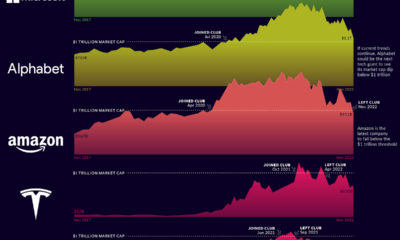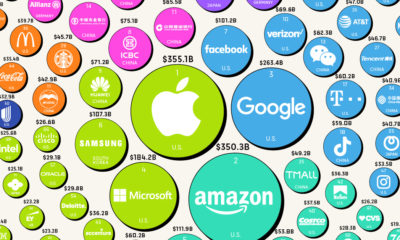In 1996, legendary Silicon Valley entrepreneur Jim Clark launched his third startup, Healtheon, which was focused on what he called the “Magic Diamond”. The diamond represented the $1.5 healthcare market in the U.S. and its shape came from the doctors, providers, payers, and consumers slotted into the four outer points. In the middle of the diamond, Clark had placed his new company Healtheon, which he expected to profit immensely from connecting the healthcare world together with the internet.
Before Its Time?
Healtheon had a successful IPO in the middle of the Dotcom bubble, but it never was able to truly achieve its bold and original vision. As signals mounted that Dotcom stocks would implode, the fledgling company merged with WebMD in 1999. Today’s infographic from Koeppel Direct shows how this is all playing out, as well as the specific initiatives that big technology companies are using to gain a foothold in a market that’s ripe for change.
And for technology companies focused on big data, the healthcare market is a compelling opportunity.
Healthcare Market Potential
By the numbers, here is a snapshot of the healthcare market, and why big tech wants in:
Global healthcare spending is expected to reach $8.7 trillion by 2020 In the U.S., there will be 98.2 million people aged 65+ years by 2060 Diabetes will affect 642 million people globally by 2040 70% of healthcare firms are investing in consumer-facing tech, like apps, remote monitoring, and virtual care Wearable tech could drop hospital costs by 16% over the course of five years Remote patient monitoring tech could save the healthcare system $200 billion over the next 25 years Over 80% of consumers say that wearable tech has the potential to make healthcare more convenient 88% of physicians want patients to monitor health parameters at home
Scientific advancements and technology have already been responsible for saving billions of lives through history, and now it’s time to see if big tech can step up to the plate using AI, augmented reality, big data, and other technologies to do more of the same – especially if it helps move these companies closer to the center of the “diamond”.
on But fast forward to the end of last week, and SVB was shuttered by regulators after a panic-induced bank run. So, how exactly did this happen? We dig in below.
Road to a Bank Run
SVB and its customers generally thrived during the low interest rate era, but as rates rose, SVB found itself more exposed to risk than a typical bank. Even so, at the end of 2022, the bank’s balance sheet showed no cause for alarm.
As well, the bank was viewed positively in a number of places. Most Wall Street analyst ratings were overwhelmingly positive on the bank’s stock, and Forbes had just added the bank to its Financial All-Stars list. Outward signs of trouble emerged on Wednesday, March 8th, when SVB surprised investors with news that the bank needed to raise more than $2 billion to shore up its balance sheet. The reaction from prominent venture capitalists was not positive, with Coatue Management, Union Square Ventures, and Peter Thiel’s Founders Fund moving to limit exposure to the 40-year-old bank. The influence of these firms is believed to have added fuel to the fire, and a bank run ensued. Also influencing decision making was the fact that SVB had the highest percentage of uninsured domestic deposits of all big banks. These totaled nearly $152 billion, or about 97% of all deposits. By the end of the day, customers had tried to withdraw $42 billion in deposits.
What Triggered the SVB Collapse?
While the collapse of SVB took place over the course of 44 hours, its roots trace back to the early pandemic years. In 2021, U.S. venture capital-backed companies raised a record $330 billion—double the amount seen in 2020. At the time, interest rates were at rock-bottom levels to help buoy the economy. Matt Levine sums up the situation well: “When interest rates are low everywhere, a dollar in 20 years is about as good as a dollar today, so a startup whose business model is “we will lose money for a decade building artificial intelligence, and then rake in lots of money in the far future” sounds pretty good. When interest rates are higher, a dollar today is better than a dollar tomorrow, so investors want cash flows. When interest rates were low for a long time, and suddenly become high, all the money that was rushing to your customers is suddenly cut off.” Source: Pitchbook Why is this important? During this time, SVB received billions of dollars from these venture-backed clients. In one year alone, their deposits increased 100%. They took these funds and invested them in longer-term bonds. As a result, this created a dangerous trap as the company expected rates would remain low. During this time, SVB invested in bonds at the top of the market. As interest rates rose higher and bond prices declined, SVB started taking major losses on their long-term bond holdings.
Losses Fueling a Liquidity Crunch
When SVB reported its fourth quarter results in early 2023, Moody’s Investor Service, a credit rating agency took notice. In early March, it said that SVB was at high risk for a downgrade due to its significant unrealized losses. In response, SVB looked to sell $2 billion of its investments at a loss to help boost liquidity for its struggling balance sheet. Soon, more hedge funds and venture investors realized SVB could be on thin ice. Depositors withdrew funds in droves, spurring a liquidity squeeze and prompting California regulators and the FDIC to step in and shut down the bank.
What Happens Now?
While much of SVB’s activity was focused on the tech sector, the bank’s shocking collapse has rattled a financial sector that is already on edge.
The four biggest U.S. banks lost a combined $52 billion the day before the SVB collapse. On Friday, other banking stocks saw double-digit drops, including Signature Bank (-23%), First Republic (-15%), and Silvergate Capital (-11%).
Source: Morningstar Direct. *Represents March 9 data, trading halted on March 10.
When the dust settles, it’s hard to predict the ripple effects that will emerge from this dramatic event. For investors, the Secretary of the Treasury Janet Yellen announced confidence in the banking system remaining resilient, noting that regulators have the proper tools in response to the issue.
But others have seen trouble brewing as far back as 2020 (or earlier) when commercial banking assets were skyrocketing and banks were buying bonds when rates were low.

















